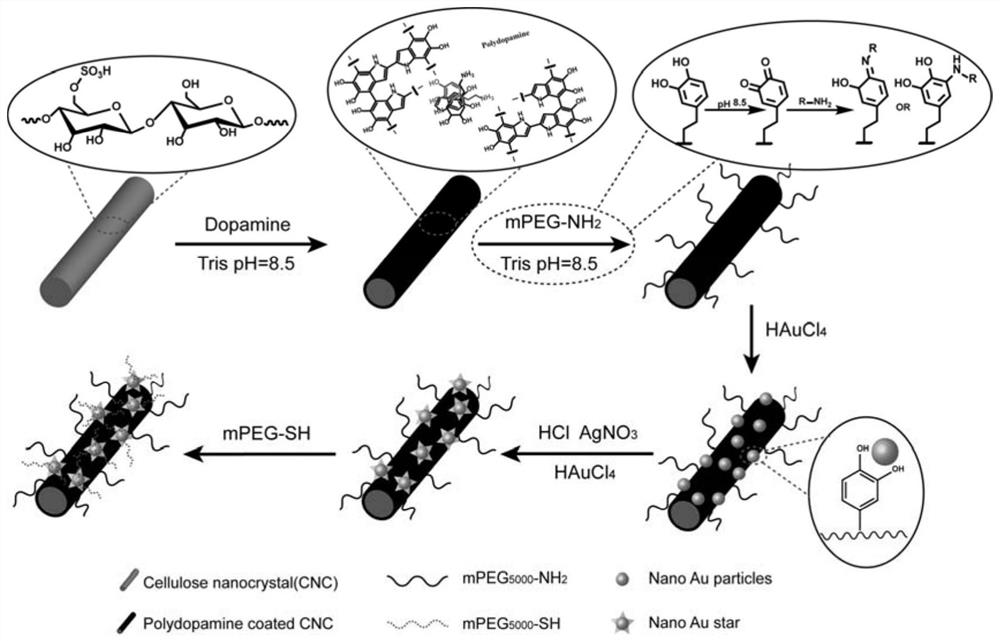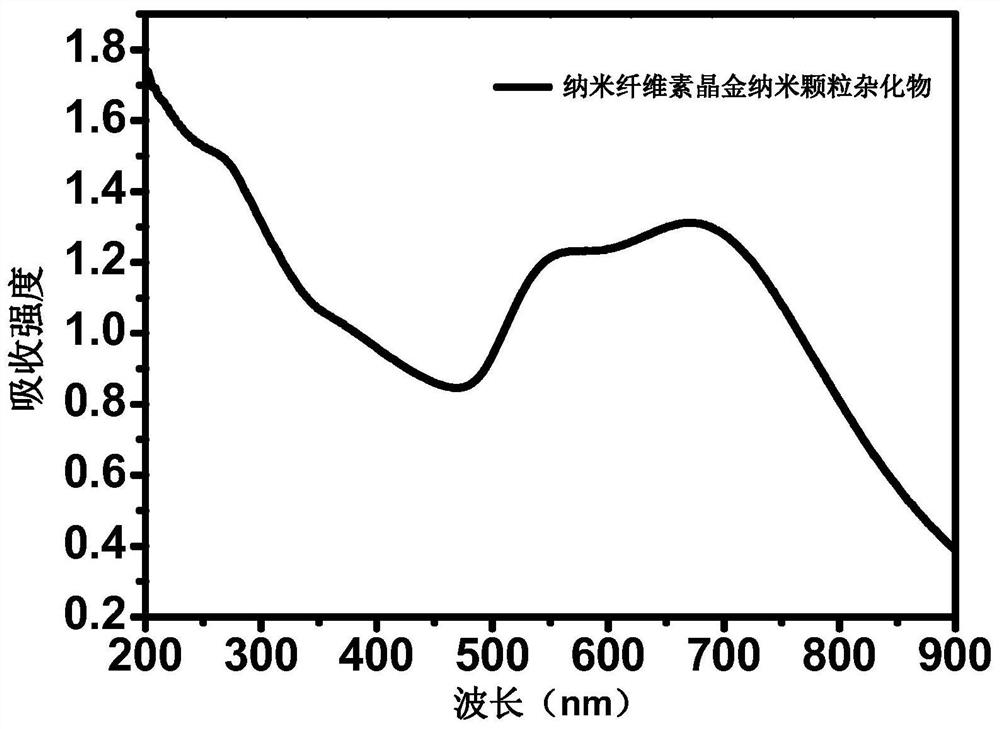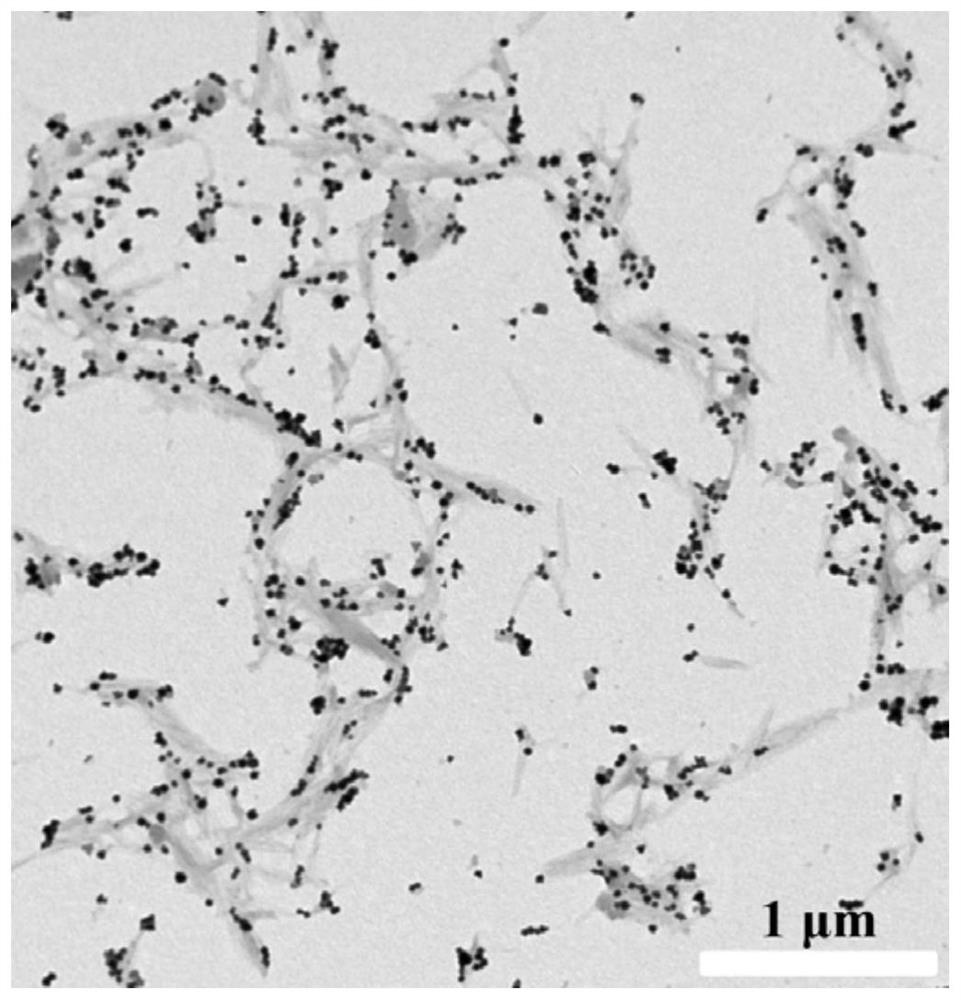Organic-inorganic hybrid multifunctional biological material based on nanocellulose crystals and preparation method and application thereof
A technology of nanocellulose and biomaterials, applied in the field of organic-inorganic hybrid multifunctional biomaterials and its preparation, can solve problems such as easy aggregation of nano-venus, high biological toxicity of protective agents, and lack of protective agents
- Summary
- Abstract
- Description
- Claims
- Application Information
AI Technical Summary
Problems solved by technology
Method used
Image
Examples
Embodiment 1
[0051] The preparation process is as figure 1 As shown, the preparation method of organic-inorganic hybrid multifunctional nanomaterials based on cellulose nanocrystals is as follows: (wherein the solution or dispersion prepared in each step is based on CNC to calculate the concentration)
[0052] (1) Sonicate the high-concentration (10mg / mL) cellulose nanocrystal (CNC) aqueous dispersion at 100kHz for 30min using a cell disintegrator to obtain a uniformly dispersed CNC dispersion;
[0053] (2) Dilute the 10mg / mL CNC dispersion to 1mg / mL with Tris-HCl (10mM, pH=8.5) buffer solution, add dopamine to ensure that the dopamine concentration in the system is 1mg / mL, and place the reaction system in an ultrasonic cleaner Ultrasonic reaction at medium 50kHz for 3h, high-speed centrifugation (20000rpm, 20min) and purification of the upper layer 3 times to prepare polydopamine-modified nanocellulose crystal particle CNC@PDA NPs dispersion;
[0054] (3) Centrifuge the CNC@PDA NPs dispe...
Embodiment 2
[0060] In vitro photoacoustic signal measurement of organic-inorganic hybrid nanomaterials based on nanocellulose crystals:
[0061] The organic-inorganic hybrid multifunctional nanomaterial based on nanocellulose crystals prepared in Example 1 was configured with ultrapure water as a solvent to have the following concentration gradients: 0.1mg / mL, 0.32mg / mL, 3.16mg / mL, 6mg / mL mL, 8mg / mL, 10mg / mL, put the above concentration materials in a centrifuge tube, use a wavelength of 720nm, and a power density of 0.5W / cm 2 The laser is used to collect photoacoustic signals, and 0.4mg / mL is selected to collect photoacoustic signals with different wavelengths. The result is as Figure 4 Figure (a) shows that the concentration of the material has a linear relationship with the photoacoustic intensity, (b) and (c) are the 2D and 3D photoacoustic imaging images of the material in the test tube respectively, and the white bright spot in the figure is the material collection. To the photoa...
Embodiment 3
[0063] In vitro photothermal performance test of organic-inorganic hybrid nanomaterials based on nanocellulose crystals:
[0064]The organic-inorganic hybrid multifunctional nanomaterial solution based on nanocellulose crystals prepared in Example 1 was configured with ultrapure water to have the following concentration gradient: 0.05mg / mL, 0.1mg / mL, 0.15mg / mL, 0.2mg / mL mL, and use ultrapure water as the control group, put the above-mentioned concentration of materials in a centrifuge tube, use a wavelength of 635nm, and a power density of 0.5W / cm 2 Irradiate for 6min. The result is as Figure 5 It can be seen from the figure that the temperature of pure water rises very little under laser irradiation, while materials with different concentrations have different degrees of temperature rise after laser irradiation, and the temperature of 0.2mg / mL material rises up to 30°C, Figure 5 It shows that the organic-inorganic hybrid nanomaterials based on nanocellulose crystals have...
PUM
 Login to View More
Login to View More Abstract
Description
Claims
Application Information
 Login to View More
Login to View More - R&D
- Intellectual Property
- Life Sciences
- Materials
- Tech Scout
- Unparalleled Data Quality
- Higher Quality Content
- 60% Fewer Hallucinations
Browse by: Latest US Patents, China's latest patents, Technical Efficacy Thesaurus, Application Domain, Technology Topic, Popular Technical Reports.
© 2025 PatSnap. All rights reserved.Legal|Privacy policy|Modern Slavery Act Transparency Statement|Sitemap|About US| Contact US: help@patsnap.com



